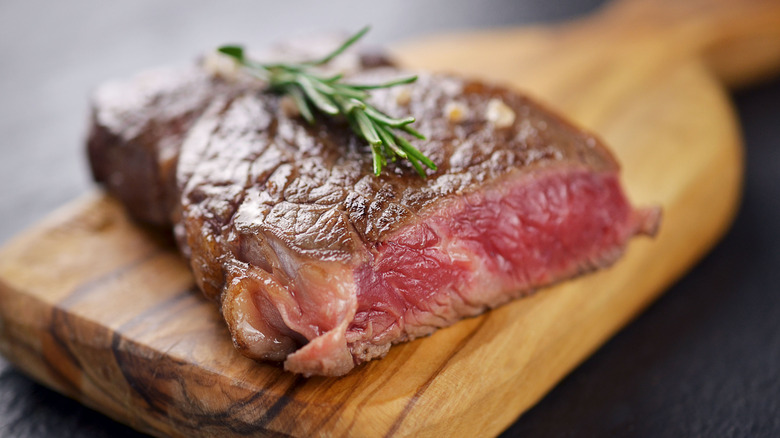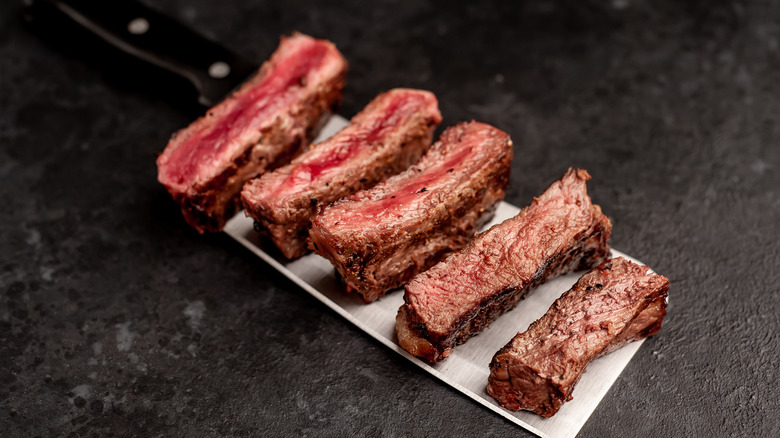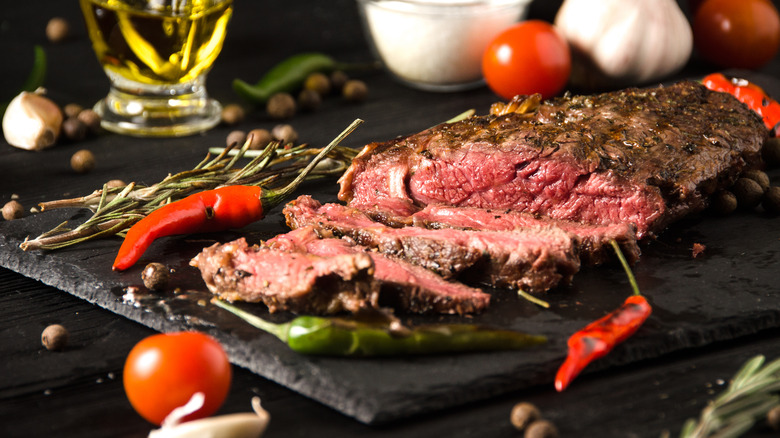When Is Steak So Rare It's Blue?
What is the right way to cook a steak? Most people seem to fall somewhere in the middle: A Tasting Table reader survey found that about 35% of Americans cook their steak medium rare. Meanwhile, medium is the most frequent order at Longhorn Steakhouse by far, while rare is the least common, according to FiveThirtyEight. Even if ordering rare steak is a rarity, less-cooked beef still has a fanbase. A handful of folks even insist on ordering their steak blue.
A blue steak is sometimes called "blue rare" or "extra rare," which is a good way to describe it: The steak is seared for only a couple of minutes, charring the outsides while just barely heating the interior. As a result, the nearly raw interior takes on a more purplish color instead of being colored deep red like a juicy rare steak. The purple-blue coloring comes from oxygen-depleted myoglobin proteins in the cut, although it turns red and eventually brownish from oxidation the longer it's left exposed.
Blue rare steak isn't considered dangerously undercooked and, when made properly, should ideally be so soft and tender that it melts in your mouth. But just because it cooks quickly doesn't mean it's easy to ace.
Cooking rare versus blue rare steak
There's more to identifying a rare or blue rare steak than just eyeballing the color of the meat. Beef's internal temperature is the official way to determine its doneness, and blue rare steaks have an internal temperature of just 115 to 120 degrees Fahrenheit. This is cool, comparatively: Rare beef sits at 125 degrees Fahrenheit, medium at 145 degrees Fahrenheit, and well-done cuts reach 160 degrees Fahrenheit.
In order to get a blue rare steak that low, it has to be "kissed" by the grill for just long enough to cook the steak's outside to a safe temperature. Cooking a blue steak is different than just cooking a rare steak less; there are a few precautions taken to make sure the beef isn't undercooked. Each side of the steak needs to be seared on the grill for just a minute or so, and it's very important that you cook all sides of the exterior to reduce any potential health risks. Sterilize your tongs before and after handling the meat, because the trade-off for a blue rare steak's decadently yielding texture is the extra vigilance needed to keep bacteria away.
How to enjoy blue rare steak safely
In general, beef should be cooked to the USDA-recommended temperature of 145 degrees Fahrenheit for safety. However, before you bust out the microscope and go checking your dinner for E. coli, you should know that the most potentially dangerous part of any steak is its exterior. This is where all the bacteria tend to live, because cows aren't prone to the kind of parasites that pigs and chickens get more often. As a result, it's typically okay for beef's internal temperature to be less than 145 degrees Fahrenheit, so long as the outside is safely cooked. This applies to rare and medium-rare steak as well.
When preparing your favorite cut of steak blue rare, you'll still want to make sure to buy high quality beef and store it correctly. Even if the outsides are seared, the inside stays close to raw and could be potentially harmful if it's been mishandled. Using a meat thermometer to keep an eye on the temperature is also important because you want to make sure you've cooked it within that 115- to 120-degree Fahrenheit range. Once the outside is seared all around and the inside is luscious, fleshy, and tender, you've got a blue rare steak that's ready to serve.
Static Media owns and operates Tasting Table and Chowhound.


